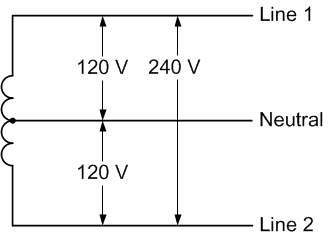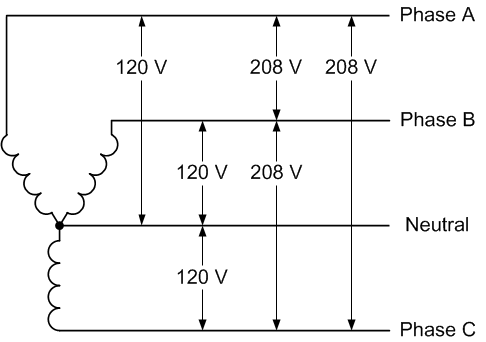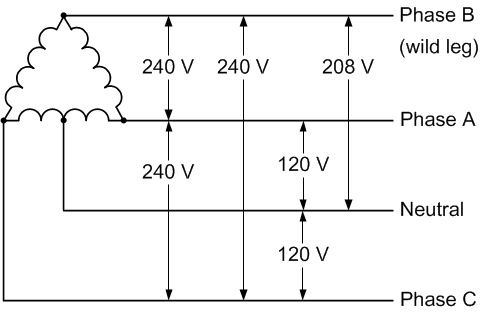This page describes various types of utility electrical services and supply voltages. The nominal system supply voltages listed below can vary by ±10% or more. WattNode® meter models are available in seven different versions that cover the full range of electrical services types and voltages. The new WattNode Wide-Range Modbus covers 100-600 Vac, wye and delta, single-phase and three-phase with a single model. Meters and current transformers are designed for use on either 50 or 60 Hz systems.
Classification of Electrical Services
Alternating current electric power distribution systems can be classified by the following properties:
- Frequency: 50 Hz or 60 Hz
- Number of phases: single or three phase
- Number of wires: 2, 3, or 4 (not counting the safety ground)
- Neutral present:
- Wye connected systems have a neutral
- Delta connected systems typically do not have a neutral
- Voltage classes: (ANSI C84.1-2016)
- Low Voltage: 1000 volts or less
- Medium Voltage: greater than 1000 volts and less than 100 kV
- High Voltage: greater than 100 kV and equal to or less than 230 kV
- Extra-High Voltage: greater than 230 kV but less than 1000 kV
- Ultra-High Voltage: equal to or greater than 1000 kV
| Wye Line-to-Neutral Voltage | Wye or Delta Line-to-Line Voltage |
|---|---|
| 120 | 208 |
| 1201 | 240 |
| 230 | 400 |
| 240 | 415 |
| 277 | 480 |
| 347 | 600 |
- Line-to-line voltages in three phase systems are typically 1.732 times the phase-to-neutral voltages:

- In symmetrical three-phase electrical system, the phase-to-neutral voltages should be equal if the load is balanced.
- Note: 1201 Refers to a three phase four wire delta service.
Common Electrical Services & Loads
- In the following drawings, the coil symbols represent the secondary winding of a utility service transformer or other step down transformer. Electrical code regulations in most jurisdictions require that the neutral conductor be bonded (connected) to the earth safety ground at the electrical service entrance.
Single Phase Three Wire
Also known as an Edison system, split-phase or center-tapped neutral. This is the most common residential service in North America. Line 1 to neutral and Line 2 to neutral are used to power 120 volt lighting and plug loads. Line 1 to Line 2 is used to power 240 volt single phase loads such as a water heater, electric range, or air conditioner.
Three Phase Four Wire Wye
The most common commercial building electric service in North America is 120/208 volt wye, which is used to power 120 volt plug loads, lighting, and smaller HVAC systems. In larger facilities the voltage is 277/480 volt and used to power single phase 277 volt lighting and larger HVAC loads. In western Canada 347/600V is common.
Three Phase Three Wire Delta
Used primarily in industrial facilities to provide power for three-phase motor loads, and in utility power distribution applications. Nominal service voltages of 240, 400, 480, 600, and higher are typical.
Download: Electrical Service Types and Voltage (AN-129) (PDF, 3 pages)
Uncommon Electrical Services
Three Phase Four Wire Delta
Also known as a high-leg or wild-leg delta system. Used in older manufacturing facilities with mostly three-phase motor loads and some 120 volt single-phase lighting and plug loads. Similar to the Three Phase Three Wire Delta discussed above but with a center-tap on one of the transformer winding to create neutral for 120 volt single-phase loads. Motors are connected to phase A, B, and C, while single-phase loads are connected to either phase A or C and to neutral. Phase B, the high or wild leg, is not used as the voltage to neutral is 208 volt.
Three Phase Two Wire Corner-Grounded Delta
Used to reduce wiring costs by using a service cable with only two insulated conductors rather then the three insulated conductors used in a convention three phase service entrance.
International Electrical Distribution Systems
| Description | L–N Vac | L–L Vac | Countries | WattNode Models (Wye or Delta–Voltage) |
|---|---|---|---|---|
| 1-Phase, 2-Wire 120 V with neutral | 120 | – | US | 3Y-208 |
| 1-Phase, 2-Wire 230 V with neutral | 230 | – | EU, Others | 3Y-400 |
| 1-Phase, 2-Wire 208 V (No neutral) | – | 208 | US | 3D-240 |
| 1-Phase, 2-Wire 240 V (No neutral) | – | 240 | US | 3D-240 |
| 1-Phase, 3-Wire 120/240 V | 120 | 240 | US | 3Y-208 |
| 3-Phase, 3-Wire 208 V Delta (No neutral) | – | 208 | US | 3D-240 |
| 3-Phase, 3-Wire 230 V Delta (No neutral) | – | 230 | Norway | 3D-240 |
| 3-Phase, 3-Wire 400 V Delta (No neutral) | – | 400 | EU, Others | 3D-400 |
| 3-Phase, 3-Wire 480 V Delta (No neutral) | – | 480 | US | 3D-480 |
| 3-Phase, 3-Wire 600 V Delta (No neutral) | – | 600 | US, Canada | none1 |
| 3-Phase, 4-Wire 208Y/120 V | 120 | 208 | US | 3Y-208, 3D-240 |
| 3-Phase, 4-Wire 400Y/230 V | 230 | 400 | EU, Others | 3Y-400, 3D-400 |
| 3-Phase, 4-Wire 415Y/240 V | 240 | 415 | Australia | 3Y-400, 3D-400 |
| 3-Phase, 4-Wire 480Y/277 V | 277 | 480 | US | 3Y-480, 3D-480 |
| 3-Phase, 4-Wire 600Y/347 V | 347 | 600 | US, Canada | 3Y-600 |
| 3-Phase 4-Wire Delta 120/208/240 Wild Phase | 120, 208 | 240 | US | 3D-240 |
| 3-Phase 4-Wire Delta 240/415/480 Wild Phase | 240, 415 | 480 | US | 3D-480 |
| 3-Phase Corner-Grounded Delta 208/240 | – | 240 | US | 3D-240 |
| 3-Phase Corner-Grounded Delta 415/480 | – | 480 | US | 3D-480 |
- 1By using potential transformers (PTs), WattNode meters can measure 600 volt delta services as well as medium and high voltage services.
Questions
- Do 3Y-600 and 3D-600 appear in the US or only in Canada?
- Yes, wye and delta 600 volt services are used in both countries but in the US they are less common.
- What services are used in Canada?
- Mostly 208Y/120 volt and 600Y/347 volt wye services and occasionally 600 volt delta too.







